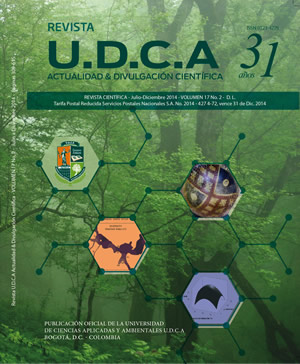Bioacumulación de naftaleno y fluoranteno en el molusco bivalvo Anadara tuberculosa (Sowerby, 1833)
Bioaccumulation of naphthalene and fluoranthene in the bivalve mollusc Anadara tuberculosa (Sowerby, 1833)
Contenido principal del artículo
Resumen
Se realizó un seguimiento a la bioacumulación de naftaleno y de fluoranteno en el molusco bivalvo Anadara tuberculosa, mediante exposición de 60 organismos, a una concentración de 0,1mg/g del compuesto de ensayo, en pruebas individuales para cada sustancia, por un periodo de 30 días. La máxima concentración de naftaleno acumulada por los organismos alcanzó los 3,42mg/g, luego de 15 días de exposición, mientras que el fluoranteno presentó niveles de 194,77mg/g, tras 5 días de prueba. En los organismos expuestos a naftaleno, se registraron variaciones en la concentración acumulada a lo largo de la prueba, contrario al comportamiento registrado en los organismos expuestos a fluoranteno, compuesto que presentó un incremento en concentración, durante la mayor parte del ensayo. Las diferencias en la cantidad acumulada de cada compuesto, se relacionan con las características fisicoquímicas de cada uno de ellos, contando el naftaleno con una menor estabilidad y mayor movilidad en los compartimentos ambientales frente al fluoranteno.
Palabras clave:
Descargas
Datos de publicación
Perfil evaluadores/as N/D
Declaraciones de autoría
- Sociedad académica
- Universidad de Ciencias Aplicadas UDCA
- Editorial
- Universidad de Ciencias Aplicadas y Ambientales U.D.C.A
Detalles del artículo
Referencias (VER)
ACOSTA, V.; NATERA, Y.; LODEIROS, C.; FREITES, L.; VÁSQUEZ, A. 2010. Componentes bioquímicos de los tejidos de Perna perna y P. viridis (Lineo, 1758) (Bivalvia: Mytilidae), en relación al crecimiento en condiciones de cultivo suspendido. Lat. Am. J. Aquat. Res. (Chile). 38(1):37-46.
ACHTEN, C; HOFMANN, T. 2009. Native polycyclic aromatic hydrocarbons (PAH) in coals - a hardly recognized source of environmental contamination. Sci. Total Environ. 407:2461-2473.
APHA, AWWA, WEF. 2005. Standard Methods for the Examination of Water and Wastewater. 21st ed. American Public Health Association. Washington, DC. Part 8000 Toxicity. 8, 94-100.
BAYNE, B.L. 1973. The responses of three species of bivalve mollusk to declining oxygen tension at reduced salinity. Comp. Biochem. Phys. 45A:793- 806.
BELFROID, A.C.; SIJIM, D.T.H.M.; VAN GESTEL, C.A.M. 1996. Bioavailability and toxicokinetics of hydrophobic aromatic compounds in benthic and terrestrial invertebrates. Environ. Rev. (Canada). 4:276-299.
BORRERO, J.F. 1986. The collection of early juveniles of Anadara spp. as a potential source of seed for culturing mangrove cockles on the Pacific coast of Colombia. Aquaculture. 59:61-69.
BOCIO, A.; CASTELL, V.; FALCÓ, G.; GOSÁLBEZ, P.; RAMOS, J. 2005. Contaminants químics, estudi de dieta total a Catalunya. Agència Catalana de Seguretat Alimentària. Generalitat de Catalunya. Generalitat de Catalunya. Barcelona (España). 143p.
BOSCOLO, R., CACCIATORE, F.; GIOVANARDI, O. 2007. Polycyclic aromatic hydrocarbons (PAHs) in transplanted Manila clams (Tapes philippinarum) from the Lagoon of Venice as assessed by PAHs/shell weight index: a preliminary study. Mar. Pollut. Bull. 55:485-493.
CALERO, L; ZAMBRANO, M. 1997. Bioacumulación de hidrocarburos aromáticos del petróleo en un molusco bivalvo Anadara tuberculosa. Bol. Cient. CCCP. (Colombia). 6:131-137.
CASANOVA, R. 1995. Estudio de la contaminación marina por compuestos organoclorados en el Pacífico colombiano. Bol. Cient. CCCP (Colombia). 5:146-160.
CCME (Canadian Council of Ministers of the Environment). 2010. Canadian Soil Quality Guidelines for Carcinogenic and Other Polycyclic Aromatic Hydrocarbons (Environmental and Human Health Effects). Scientific Criteria Document (revised). Quebec (Canada). 216p.
CSIC (Consejo Superior de Investigaciones Científicas). 2003. Impacto de un vertido de petróleo sobre los organismos marinos. Algunas lecciones del vertido del Aegean sea. Informe técnico No. 15. (España). Disponible desde Internet en: http://csicprestige.iim.csic.es/informes/info15.pdf (con acceso 03/04/2011).
FERNÁNDEZ, B.; BRUNKER, T. 1977. Estudio bacteriológico de bivalvos del Golfo de Nicoya, Costa Rica (I Parte). Rev. Biol. Trop. (Costa Rica). 25:101- 107.
FERNÁNDEZ, L.; FREIRE, J. 2005. Relaciones entre la salud de los ecosistemas marinos y la seguridad alimentaria: La marea negra del Prestige como un caso de estudio. (España). Disponible desde Internet en: http://otvm.uvigo.es/investigacion/informes/documentos/archivos/Salud_ecosistemas_seguridad_alimentaria.pdf (con acceso 04/06/2011).
HANSEN, B.H.; ALTIN, D.H.; VANG, SH.; NORDTUG, T.; OLSEN, A.J. 2007. Effect of naphthalene o gene transcription in Calanus finmarchinus (Crustacea, Copepoda). Aquatic Toxicol. 86:157-165.
HEATH, J.S.; KOBLIS, K.; SAGER, S.; DAY, C. 1993. Risk assessment for total petroleum hydrocarbons. In: Irwin, R.J.; VanMouwerik, M.; Stevens, L.; Seese, M.D.; Basham, W. (eds). Environmental Contaminants Encyclopedia Fluoranthene Entry. National Park Service, Water Resources Division, Fort Collins, Colorado. (Estados Unidos). Disponible desde internet en: http://www.nature.nps.gov/hazardssafety/toxic/fluorant.pdf (con acceso 03/04/2011).
HELLOU, J.; UPSHALL, C.; PAYNE, J.F.; NAIDU, S.; PARANJAPE, M.A. 1993. Total unsaturated compounds and polycyclic aromatic hydrocarbons in mollusks collected from waters around Newfoundland. Arch. Environ. Contam. Toxicol. 24(2):249-257.
IARC. 1983. Polynuclear Aromatic Compounds: Part 1, Chemical, environmental and experimental data. IARC Monographs on the Evaluation of Carcinogenic Risks to Humans. WHO. Vol. 32. p.95-431, (Francia). Last updated: 17 April 1998.
INCODER. 2007. Sistema de información sectorial pesquero. En: Estado actual del cultivo y manejo de moluscos bivalvos y su proyección futura: factores que afectan su sustentabilidad en América Latina. (A. Lovatelli, A. Farias e I. Uriarte eds.). Taller Técnico Regional de la FAO. 20-24 de agosto de 2007, Puerto Montt, Chile. FAO Actas de Pesca y Acuicultura. No. 12. Roma (Italia), FAO. p.115-128.
IRWIN, R.J.; VANMOUWERIK, M.; STEVENS, L.; SEESE, M.D.; BASHAM, W. 1997a. Environmental Contaminants Encyclopedia Fluoranthene Entry. National Park Service, Water Resources Division, Fort Collins, Colorado. (Estados Unidos). Disponible desde Internet en: http://www.nature.nps.gov/hazardssafety/toxic/fluorant.pdf (con acceso 07/05/2011).
IRWIN, R.J.; VANMOUWERIK, M.; STEVENS, L.; SEESE, M.D.; BASHAM, W. 1997b. Environmental Contaminants Encyclopedia Naphthalene Entry. National Park Service, Water Resources Division, Fort Collins, Colorado. (Estados Unidos). Disponible desde internet en: http://www.nature.nps.gov/hazardssafety/toxic/naphthal.pdf (con acceso 07/05/2011).
KRISHNAKUMAR, P.K.; CASILLAS, E.; VARANASI, U. 1994. Effects of environmental contaminants on the health of Mytilus edulis from Puget Sound, Washington, USA. I. Cytochemical measures of lysosomal responses in the digestive cells using automatic image analysis. Mar. Ecol. Prog. Ser. 106:249-261.
KRISHNAKUMAR, P.K.; CASILLAS, E.; VARANASI, U. 1997. Cytochemical reponses in the digestive tissue of Mytilus edulis complex exposed to microencapsulated PAH or PCBs. Comp. Biochem. Physiol. 118:11-18.
LANDRUM, P.F.; GEDEON, M.L.; BURTON, G.A.; GREENBERG, M.S.; ROWLAND, C.D. 2002. Biological Responses of Lumbriculus variegatus Exposed to Fluoranthene-Spiked Sediment. Arch. Environ. Contam. Toxicol. 42:292-302.
LIU, Y.; CHEN, L.; HUANG, Q.H.; LI, W.Y.; TANG, Y.J.; ZHAO, J.F. 2009. Source apportionment of polycyclic aromatic hydrocarbons (PAH) in surface sediments of the Huangpu River, Shangai, China. Sci. Total Environm. 407:2931-2938.
LORS, C.; PERIE, F.; GRAND, C.; DAMIDOT, D. 2009. Benefits of ecotoxicological bioassays in the evaluation of a field biotreatment of PAHs polluted soil. Global NEST J. 11(3):251-259.
MARRUGO, A.J. 1993. Estudio de la contaminación marina por hidrocarburos en el Pacífico Colombiano - Fase III. Bol. Cient. CCCP. (Colombia). 4:47-60.
OKAY, O.S.; DONKIN, P.; PETERS, L.D.; LIVINGSTONE, D.R. 2000. The role of algae (Isochrysis galbana) enrichment on the bioaccumulation of benzo[a] pyrene and its effects on the blue mussel Mytilus edulis, Environ. Pollut. 110:103-113.
PANE, L.; BOCCARDO, S.; BONFIGLIOLI, F.; MARIOTTINI, G.L.; PRIANO, F.; CONIO, O. 2005. Polycyclic aromatic hydrocarbons in water, seston and copepods in a harbour area in the Western Mediterranean (Ligurian Sea). Mar. Ecol. 26:89-99.
PEÑA, A.; MORALES, J.; LABASTIDA, A.; CAPELLA, S. 2003. Extracción en Fase Sólida como una Alternativa para el Procedimiento de Limpieza en la Determinación de Hidrocarburos Aromáticos Policíclicos por Cromatografía de Gases. Rev. Int. Contam. Ambient. (México). 19(1):13-23.
PRAHL, H. von; CANTERA, J.R.; CONTRERAS, R. 1990. Manglares y hombres del Pacífico colombiano. Fondo FEN. Bogotá (Colombia). 193p.
PREUSS, R.; ANGERER, J.; DREXLER, H. 2003. Naphthalene an environmental and occupational toxicant. Int. Arch. Occup. Environ. Health. 76(8):556-576.
REY-SALGUEIRO, L.; MARTÍNEZ-CARBALLO, E.; GARCÍA-FALCÓN, M.; SIMAL-GÁNDARA, J. 2009. Survey of polycyclic aromatic hydrocarbons in canned bivalves and investigation of their potential sources. Food. Res. Int. 42:983-988.
RILEY, R.T.; MIX, M.C.; SCHAFFER, R.L.; BUNTING, D.L. 1981. Uptake and accumulation of naphthalene by the oyster Ostrea edulis, in a flow-through system. Mar. Biol. 61(4):267-276.
RUSSELL, M.L.; GOTH-GOLDSTEIN, R.; APTE, M.G.; FISK, W.J. 2002. Analytical Method for the determination of Individual (N-alkanes and Isoprenoids) and Total Petroleum Hydrocarbons (TPH), Polycyclic Aromatic Hydrocarbons (PAHs) and Biomarker Triterpanes and Steranes in Oil and Oil-spill-related. Environmental Samples (Water, Particulates and Soils/Sediment): Berkeley (CA): Lawrence Berkeley National Laboratory, Environmental Energy Technologies Division 2002 Jan. Report No.: LBNL49574. Contract No.: DEAC0376SF00098. Sponsored by the Department of Energy. Ottawa. ON, K1A 0H3.
SERICANO, J.L.; WADE, T.L.; JACKSON, T.J.; BROOKS, J. M.; TRIPP, B.W.; FARRINGTON, J.W.; MEE, L.D.; READMAN, J.W.; VILLENEUVE, J.P.; GOLDBERGS, E.D. 1995. Trace organic contamination in the Americas: An Overview of the US National Status & Trends and the International "Mussel Watch" Programmes. Mar. Pollut. Bull. 31(4-12):214-225.
SILVA BENAVIDES, A.M.; BONILLA CARRIÓN, R. 2001. Abundancia y morfometría de Anadara tuberculosa y A. similis (Mollusca: Bivalvia) en el Manglar de Purruja, Golfo Dulce, Costa Rica. Rev. Biol. Trop. (Costa Rica). 49(2):315-320.
VAGI, M.C.; KOSTOPOULOU, M.N.; PETSAS, A.S.; LALOUSI, M.E.; RASOULI, C.H.; LEKKAS, T.D. 2005. Toxicity of organophoshorous pesticides to the marine alga Tetraselmis suecica. Global NEST J. 7(2):222-227.
VELÁSQUEZ, O.; CORTES, L.M. 1997. Estudio y evaluación de metales traza (Pb, Cr, Cu, Cd y Hg) en aguas, sedimentos y organismos marinos de la bahía de Buenaventura. Bol. Cient. CCCP (Colombia). 6:57-61.
VIJAYAVEL, K.; GOMATHI, R.D.; DURGABHAVANI, K.; BALASUBRAMANIAN, M.P. 2004. Sublethal effect of naphthalene on lipid peroxidation and antioxidant status in the edible marine crab Scylla serrata. Mar. Pollut. Bull. 48:429-433.
ZAGHDEN, H.; KALLEL, M.; ELLEUCH, B.; OUDOT, J.; SALIOT, A. 2007. Sources and distribution of aliphatic and polyaromatic hydrocarbons in sediments of Sfax, Tunisia. Mediterranean Sea, Mar. Chem. 105(1-2):70-89.







